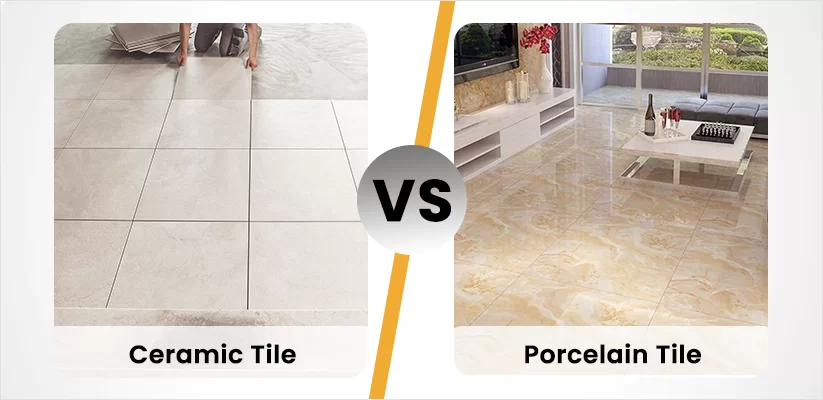When choosing the perfect tile for your home or commercial space, the abundance of options can be overwhelming. Among the most popular choices are ceramic and porcelain tiles. While they share similarities, they possess distinct qualities that make them suitable for different applications. It’s a battle of strength, style, and suitability. Whether revamping your kitchen, renovating a bathroom, or embarking on a commercial project, understanding the differences between these tiles is essential.
Post your Requirement
What Are Ceramic Tiles?
Ceramic tiles are a popular type of tile made from a mixture of clay, minerals, and water. They are created through a process of molding and firing the clay mixture in a kiln. Ceramics are known for their versatility and wide range of design options. They come in various sizes, shapes, colours, and patterns, allowing for endless possibilities when it comes to creating unique and visually appealing surfaces. The final step in manufacturing ceramic tiles involves applying a glaze, which adds colour, texture, and protection to the tile’s surface. Ceramic tiles are commonly used for indoor applications, such as floors, walls, backsplashes, and countertops, and offer a balance of affordability, durability, and aesthetic appeal.
Advantages Of Ceramic Tiles:
- Affordability: Ceramic tiles are generally more budget-friendly compared to porcelain tiles, making them a cost-effective option for those on a tighter budget.
- Versatility in Design: Ceramic tiles offer a wide range of design options, including various colours, patterns, and textures. They can mimic the appearance of natural stone, wood, or other materials, providing a versatile and customizable look for your space.
- Ease of Installation: Ceramic tiles are relatively easy to install, making them suitable for DIY projects. They are lighter in weight compared to porcelain tiles, which can simplify the installation process.
- Easy Maintenance: Ceramic tiles are easy to clean and maintain. Regular sweeping and occasional mopping with a mild detergent are usually sufficient to keep them looking their best.
Read in Detail: What are the advantages and disadvantages of Ceramic Tiles?
What Are Porcelain Tiles?
Porcelain tiles are a type of tile renowned for their exceptional durability, strength, and versatility. They are made from a mixture of fine-grain clays and minerals, including kaolin, feldspar, and silica. The manufacturing process for porcelain tiles involves subjecting the clay mixture to higher temperatures and greater pressure compared to ceramic tiles. This results in a denser and more compact tile with a lower water absorption rate.
Advantages Of Porcelain Tiles:
- Durability and Strength: Porcelain tiles are extremely durable and long-lasting. Their dense composition and manufacturing process makes them highly resistant to chips, scratches, and wear. They can withstand heavy foot traffic and are suitable for both residential and commercial applications.
- Water Resistance: Porcelain tiles have a very low water absorption rate, making them highly resistant to water damage. This makes them ideal for being prone to moisture, such as in bathrooms, kitchens, and outdoor spaces.
- Versatility in Application: Porcelain tiles can be used for both indoor and outdoor applications due to their excellent durability and resistance to various environmental conditions.
- Design Options: Porcelain tiles offer a wide range of design options, including realistic textures, patterns, and colours. They can replicate the look of natural stone, wood, or other materials with great accuracy.
Read Also: The Different Types of Porcelain Tiles And Their Benefits
Key Difference Between Ceramic Tiles And Porcelain Tiles
-
Composition And Manufacturing Process:
Ceramic Tile:
Ceramic tiles are primarily composed of clay mixed with various minerals and water. The mixture is then molded into the desired shape and fired in a kiln. The glaze, which provides colour and design, is applied before the final firing.
Porcelain Tile:
Porcelain tiles are made from a blend of fine-grain clays and minerals, often including kaolin, feldspar, and silica. The mixture is subjected to higher temperatures and greater pressure during the manufacturing process compared to ceramic tiles. This results in a denser and more durable tile.
-
Water Absorption And Durability:
Ceramic Tile:
Ceramic tiles are known for their relatively higher water absorption rate, usually around 4% to 7%. This makes them more susceptible to water damage, particularly in areas with high moisture, such as bathrooms. Consequently, ceramic tiles are typically recommended for indoor applications.
Porcelain Tile:
Porcelain tiles are renowned for their low water absorption rate, usually less than 0.5%. The denser composition and manufacturing process makes them highly resistant to water penetration, making them suitable for both indoor and outdoor use. Porcelain tiles are especially recommended for areas prone to water exposure, such as bathrooms, kitchens, and even outdoor patios.
-
Strength And Resistance:
Ceramic Tile:
While ceramic tiles offer a wide range of design options, they are generally not as strong or durable as porcelain tiles. They are more prone to chipping and cracking under heavy impact or stress. Therefore, they are best suited for areas with lighter foot traffic, such as bedrooms or living rooms.
Porcelain Tile:
Porcelain tiles are incredibly strong and durable. Their dense structure and manufacturing process result in excellent resistance to impact, scratches, and wear. This makes them an ideal choice for high-traffic areas like hallways, entryways, and commercial spaces.
-
Design And Style:
Ceramic Tile:
Ceramic tiles are available in a plethora of designs, colours, patterns, and textures. The glazing process allows for endless possibilities in terms of aesthetics, enabling you to find the perfect fit for your desired look and feel.
Porcelain Tile:
Porcelain tiles also offer a wide range of design options, including styles that mimic natural stone, wood, or concrete. The advanced manufacturing techniques used for porcelain tiles allow for highly realistic textures and patterns. Additionally, the colour of porcelain tiles is consistent throughout the tile, making any chips or scratches less noticeable.
Conclusion
Understanding the differences between ceramic and porcelain tiles is crucial to selecting the right material for your specific needs. If you prioritize water resistance, durability, and strength, porcelain tiles are the way to go. On the other hand, if you are seeking versatile design options and are working within a budget, ceramic tiles may be more suitable. By considering factors such as location, foot traffic, and desired aesthetics, you can confidently make an informed decision for your tiling project and create a space that’s both functional and visually appealing.
Read Also: Top 10 Tile Companies In India























Post A Comment